The paramount importance of security in automobiles cannot be overstated. Driver alertness plays a vital role, but it is subject to various constraints. While physical and psychological balance are crucial for safety, individuals with physical or psychological challenges who drive under the influence of alcohol can cause accidents. It is imperative to consider both physical fitness and psychological well-being, as even individuals in good condition may succumb to accidents due to excessive alcohol consumption. Driving while intoxicated affects personal judgment and the ability to perceive vehicles and obstacles on the road. The legal limit for blood alcohol concentration is typically between 0.01% and 0.08%, but surpassing the upper threshold of 0.08% can lead to severe accidents, which is a significant cause for concern. Thus, this paper focuses on detecting alcohol-impaired drivers and alerting both passengers and drivers through alarming signals.
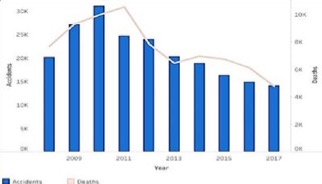
According to a report by the Government of India (Ministry of Road Transport and Highways) in 2017, there were a total of 464,910 accidents on Indian roads, with 14,071 accidents attributed to drunk driving. India has earned an unfortunate reputation for a high number of accidents caused by drunk driving, endangering lives and properties. Intoxicated drivers are unable to maintain control of their vehicles, posing a serious threat to road safety. Under no circumstances should such individuals be allowed to operate a vehicle.
Currently, law enforcement relies on manual breathalyzers to detect alcohol consumption. These devices require drivers to blow into them to measure blood alcohol levels. If alcohol exceeding 30 milligrams per 100 millilitres of blood is detected, the driver can face penalties under Section 185 of The Motor Vehicles Act, 1988, including fines of up to Rs 2,000 and/or imprisonment for up to six months for a first offense.
However, breathalyzers have limitations as they can only detect alcohol after an accident has already occurred. Additionally, their accuracy is affected by various physiological factors, such as weight, external temperature, and breathing patterns.
During a vehicle accident, immediate lifesaving measures are crucial. Promptly stopping blood loss and providing critical care can be lifesaving. Therefore, equipping vehicles with an alert mechanism can transform conventional vehicles into smart vehicles. Installing Global Positioning System (GPS) and Global System for Mobile Communication (GSM) technology in vehicles can attract the attention of healthcare professionals and facilitate the shipment of patients to intensive care units, ultimately reducing the mortality rate. GPS systems are versatile and can accurately determine the accident location. An electromechanical system is used to detect vehicle vibrations, which activates the GSM and GPS systems through a control device. Alert messages are then transmitted to nearby hospitals and relevant personnel.
Research has highlighted the use of an automatic signalling system currently implemented in western China. The device’s principle and accident detection method are described. It can be used in various types of vehicles, differentiating false alarms during normal driving conditions and accurately identifying accidents by simulating head-on collisions. This device aims to mitigate accidents caused by excessive speed. Immediate notification of emergency services could potentially save lives. Navigation systems have become integral to vehicles, and by using a GPS receiver to monitor a vehicle’s speed and detect accidents based on speed changes, the system can send position information to an Alert Service Department. By employing a Microcontroller Unit, the GPS can continuously monitor the vehicle’s speed and compare it to previous readings. If the speed falls below a specified threshold, an accident is presumed to have occurred. The GPS then transmits the accident location, speed, and time via the GSM network, enabling emergency response teams to arrive in a timely manner and save lives.
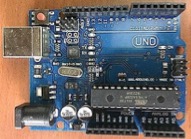
Some studies emphasize technology and infrastructure advancements to prevent road accidents. For example, the use of a Microelectromechanical System (MEMS) sensor to detect vehicle accidents, with Arduino processing the data. The Arduino alarm signal, containing the location information, is transmitted via a SIM card to the police control or rescue command. The police can use a GPS module to track the location and take appropriate actions.
Other studies propose using the accelerometer in an auto alarm app to detect dangerous driving behaviours, such as crashes or rollovers. The accelerometer detects significant collisions and sends signals to the ATMEGA 8A controller. The microcontroller then sends a GSM alarm message to the police control center or rescue crew. The police can track the location using GPS and take necessary measures. In case of an accident without injuries or immediate danger to life, the driver can disable the warning message using a provided switch, avoiding unnecessary intervention from recovery teams. A vibration sensor is used to detect emergencies. Researchers have explored smartphone applications as a means of detecting and notifying vehicle accidents, utilizing accelerometer and GPS data. However, such systems may be subject to fraudulent accident reports due to reliance on a single sensor, the vehicle’s position.
One study proposes a system that utilizes gravitational pull, tempo, and loudness to identify accidents. When an emergency alert is received, a web server sends a text message to the emergency telephone. This system shares similarities with our proposed model as it utilizes some of the same sensors. However, a potential drawback is misreporting accidents at lower speeds when the system cannot determine whether the client is inside the vehicle.
Another technique presented involves using an accelerometer to detect collisions and sending information to an emergency dispatch server via GSM messaging. Once again, this system relies solely on a single sensor to detect collisions. It suggests a GPS-based system for detecting and tracking vehicle accidents. Drive on Transitions detects accidents and transmits the location via GSM to a consumer’s mobile number.
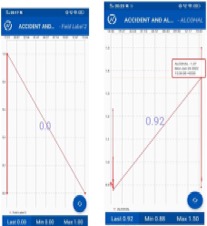
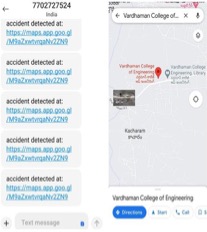
A comprehensive system is proposed to monitor alcohol concentration and traffic accidents. The MQ03 sensing module detects the presence of alcohol and sends the information, along with a whistle sound, to ThingSpeak through the internet. Vibration sensors are used to identify accident victims and send alert messages, including location details, to nearby hospitals. The system automatically detects alcohol concentration and accidents on the road. The MQ03 sensor detects the presence of alcohol and communicates with the sensor module through the I2C interface. LEDs and buzzers are utilized for the alarm system, indicating accidents or detected alcohol levels.
The user interface is designed to be unobtrusive, improving the accuracy of detecting intoxicated individuals and saving passengers’ lives in case of accidents. User feedback is not required. By combining the MQ-03 alcohol sensor with the car ignition system, alcohol detection can be enhanced. Using a GSM module and GPS module, accident detection in a car becomes feasible. Whenever a car crash or collision occurs, the technology sends a message to the closest emergency service center (e.g., 108 Ambulance) with the accident location.
Car crash sensors are employed to detect collisions occurring in any direction. Vibrator sensors are placed at each corner of the car to assess damage to the vehicle’s body. If a collision is detected, the sensors send signals to the microcontroller, which determines that an accident has occurred. An emergency message containing the accident location is then sent to the nearest police station, and the microcontroller assesses whether there is any movement inside the car to determine if the individual is alive. If no movement is detected, the system alerts the nearest medical emergency hospital.
The MQ-03 sensor, capable of detecting alcohol vapor or air, is utilized to identify alcohol consumption by the driver. When alcohol is detected, the sensor sends a signal to the Arduino. The microcontroller serves as the CPU of the overall circuit and prevents the vehicle from starting if the driver is intoxicated. If the driver is not drunk, the system allows the vehicle to start. In the event of the driver becoming intoxicated while driving, the system displays an alert message and activates a buzzer sound.
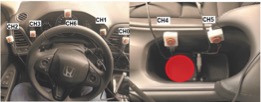
In any emergency situation, medical assistance is crucial. Therefore, a panic button function is implemented to send an emergency message for medical assistance to the nearest ambulance or healthcare facility based on the user’s current location.
To ensure continuous access to the benefits of these lifesaving vehicle safety technologies, the government should prioritize the implementation of strong performance standards and encourage auto industry safety innovation. Automakers should equip effective versions of these features as standard across all models and continuously improve their safety benefits. Delaying these measures would put people at risk and waste opportunities for essential auto industry innovations.
In conclusion, incorporating advanced technologies, such as sensors, GPS, GSM, and accelerometers, can significantly enhance security and safety in automobiles. Detecting and preventing accidents, monitoring driver alertness, and providing immediate assistance in emergencies are crucial aspects of automotive security. By leveraging these technologies and implementing robust systems, we can minimize the risks associated with drunk driving, improve response times to accidents, and ultimately save lives.
Written by – Tatha Biswas
Edited by – Kushi Mayur
